In the dynamic world of producing beats, the ability to incorporate unique and captivating trap chord progressions is an asset.
This is an invaluable skill that creates a significant distinction between the experienced beatmakers and the amateurs.
It allows one to imbue their music with depth and emotion, yielding a richer, more engaging listening experience.
For both seasoned and novice producers, understanding the mechanics behind these progressions is key.
This is fundamental in mastering the art of producing exceptional beats.
In this article, we will delve into how you can employ diverse and well-structured trap chord progressions to refine your music and keep your listeners hooked.
Table of Contents
- Trap Chord Progressions
- I – IV – V – vi (1 – 4 – 5 – 6)
- ii – V – I (2 – 5 – 1)
- I – ii – iii – IV (1 – 2 – 3 – 4)
- V – iii – IV – vi (5 – 3 – 4 – 6)
- I – iii – vi – IV (1 – 3 – 6 – 4)
- ii – vi – iii – IV (2 – 6 – 3 – 4)
- I – V – vi – IV (1 – 5 – 6 – 4)
- vii° – I – iii – IV (7 – 1 – 3 – 4)
- V – I – IV – iii (5 – 1 – 4 – 3)
- iii – vi – ii – V (3 – 6 – 2 – 5)
- vi – IV – ii – V (6 – 4 – 2 – 5)
- ii – IV – I – vi (2 – 4 – 1 – 6)
- I – IV – vii° (1 – 4 – 7)
- I – ii – vi – IV (1 – 2 – 6 – 4)
- vii° – iii – vi – ii (7 – 3 – 6 – 2)
- I – V – ii – IV (1 – 5 – 2 – 4)
- ii – V – iii – IV (2 – 5 – 3 – 4)
- The Bottom Line
Trap Chord Progressions
I – IV – V – vi (1 – 4 – 5 – 6)
Climactic chords that give rise to a riveting trap beat.
This I – IV – V – vi chord progression is a popular sequence in Trap music, known for its powerful emotional resonance and rhythmic drive. The progression provides a solid foundation for a variety of melodies and percussive patterns, inherently elevating the overall feel and quality of your beats.
- Difficulty: Easy
- Example: C – F – G – Am (Key of C Major)
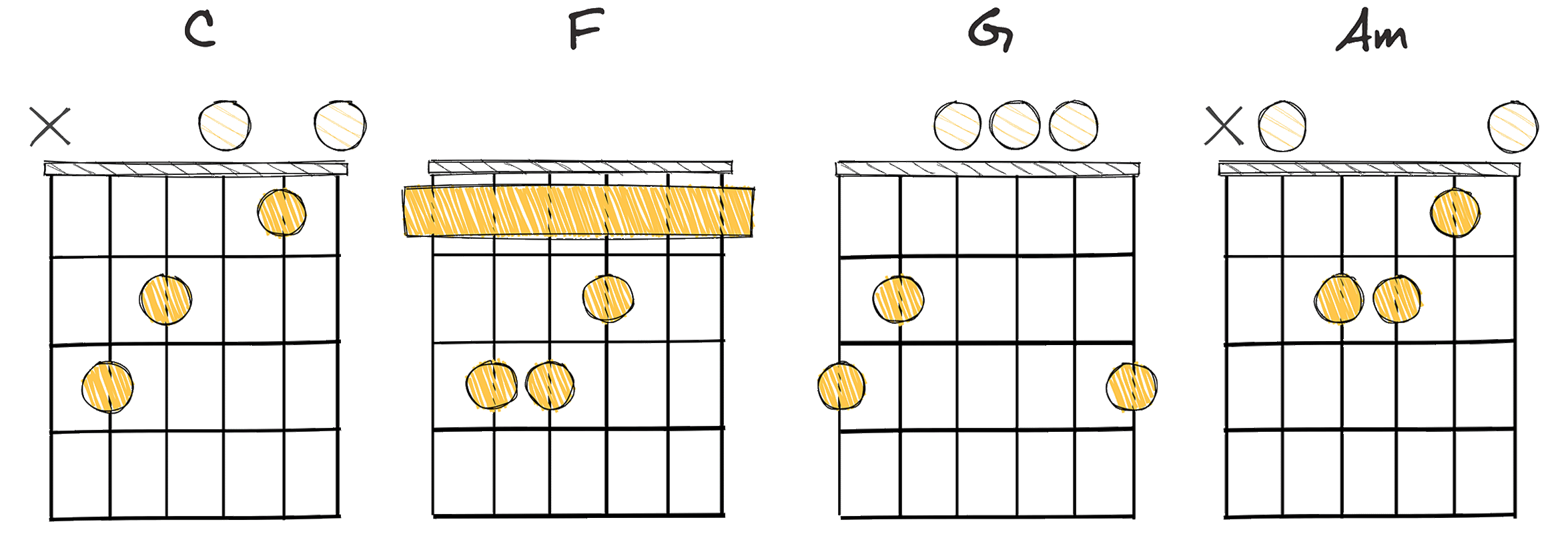
Chord progression I – IV – V – vi (1 – 4 – 5 – 6) is a fundamental sequence in many genres of music, especially in the world of trap beats.
Essentially, this corresponds to the key of C Major and constitutes the chords C Major – F Major – G Major – A Minor.
One of the key factors attributing to its widespread appeal is the fact that it is considered easy to play.
This chord sequence simplifies things for composers, providing them with a flexible foundation upon which they can experiment and embellish.
It’s worth mentioning that the simplicity does not compromise the capacity for complexity in the final composition.
The I – IV – V – vi chord progression, with its innate simplicity and scope for embellishment, can be manipulated to create a variety of musical moods and atmospheres.
This versatility allows producers to weave intricate, multifaceted aural narratives, rendering this chord progression a prolific tool in their musical arsenal.
It can elicit a range of emotions from the listener, depending on the rhythm, instrumentation, and tempo used by the producer.
Moreover, the flexibility of this chord progression makes it an excellent option for producers looking to experiment or push their creative boundaries.
A historical viewpoint also highlights the significance of the I – IV – V – vi progression.
It is deeply embedded in the musical traditions from ancient to modern times, marking its enduring appeal.
Throughout the history of music, this progression has been a go-to for many composers, regardless of the genre they are working in.
Many trap producers use these progressions as a template and then modify it to fit their unique style.
ii – V – I (2 – 5 – 1)
The keystone progression for crafting compelling trap beats.
The ii – V – I (2 – 5 – 1) progression is a foundational sequence frequently used in trap music, known for producing a soulful, harmonic sound that infuses richness into your beats. This progression is celebrated for its versatile and effective shift of tonalities, injecting rhythmic tension and release that can significantly enhance the complexity and appeal of your track.
- Difficulty: Easy
- Example: Dm – G – C (Key of C)
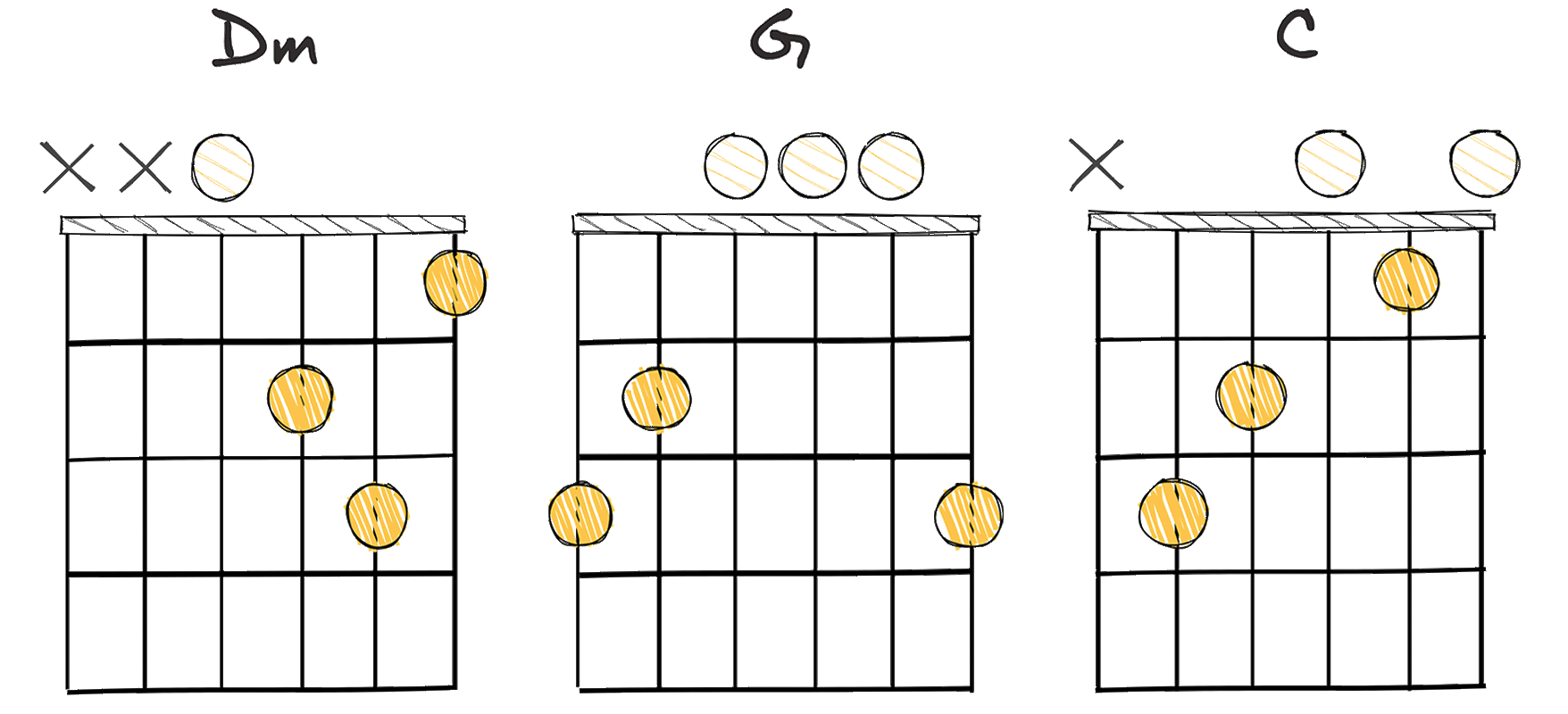
When discussing trap chord progressions, the ii – V – I (Dm – G – C, in the key of C) sequence is an essential tool for composers in the genre to understand fully.
This classic progression, also known as the perfect cadence, has a long history that dates back to the baroque era.
Its timeless appeal and inherent musicality make it an extremely versatile tool.
Despite originating from classical music, the ii – V – I progression seamlessly fits into modern trap beats, adding both sophisticated harmony and ear-catching tension.
This successful transition from classical to contemporary compositions can be attributed to the progression’s musical tension and resolution, essential for crafting engaging melodies.
The ii – V – I progression also aids in providing a stable musical foundation, allowing for more bold and experimental melodic and rhythmic elements to take center stage.
In addition, it is notably easy to play, making it an attractive option for beginner and veteran producers alike.
Furthermore, this progression can easily be manipulated; the order of chords can be played around with to add originality and a personal touch to beats.
This flexibility allows composers to experiment with chord extensions, inversions, and substitutions to add more depth and complexity to their music.
The trap genre is renowned for its distinct sound – using this progression can help keep that foundation while also exploring new harmonic landscapes.
Moreover, using the ii – V – I progression showcases the influence of classic and jazz arrangements in trap beats, adding an unexpected layer of sophistication and class to the high-energy and visceral style.
Understanding and experimenting with the ii – V – I progression can undoubtedly open doors to new creative possibilities for trap composers, providing an array of intriguing musical options.
The inherent tension and resolution found within this progression truly gives an emotional arc to the music, which can make it resonate more with listeners.
Ultimately, exploiting well-established chord progressions such as ii – V – I in trap beats can result in surprisingly fresh and musically intriguing tracks, ensuring the beats are enticing and sonically sophisticated.
I – ii – iii – IV (1 – 2 – 3 – 4)
A well-regarded chord sequence found in various musical styles, not least in the world of trap music.
The I – ii – iii – IV progression in C major creates a melodious journey. Beginning with the solid grounding of the C chord, it weaves through a gentle Dm, adds complexity with an Em, and resolves satisfyingly with the F chord. This sequence offers a blend of stability and emotion, making it versatile and rich in character, particularly suitable for the innovative beats of trap music.
- Difficulty: Intermediate
- Example: C – Dm – Em – F (Key of C Major)
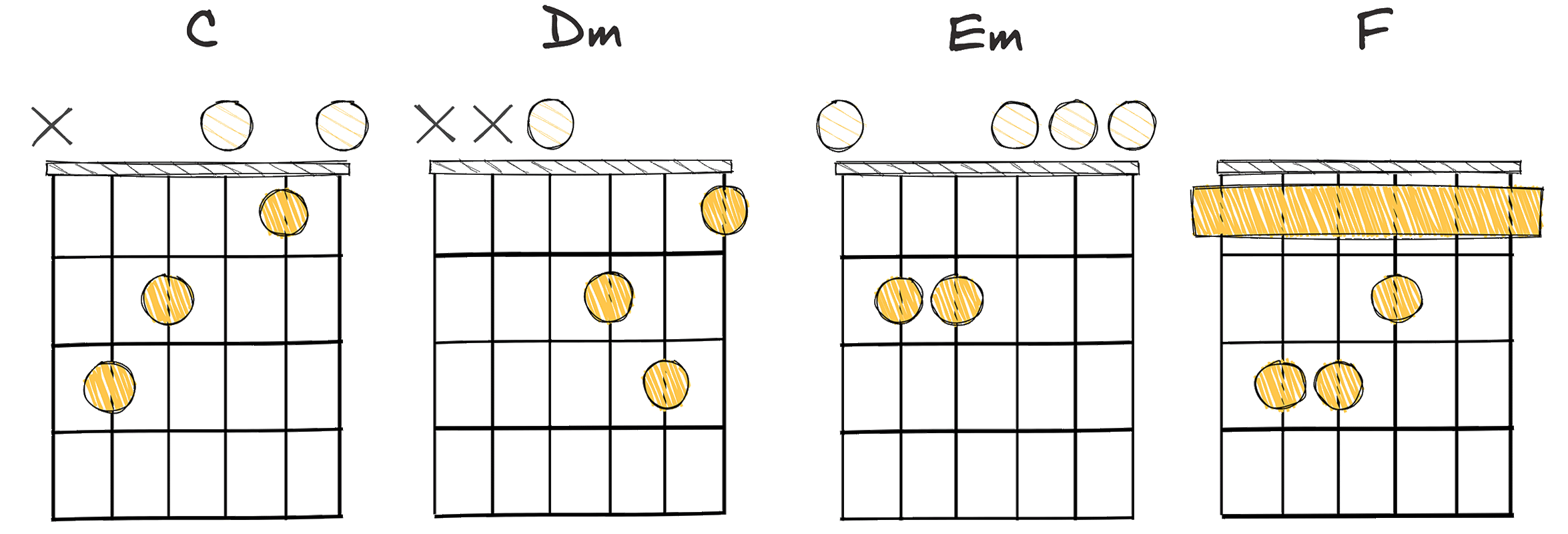
The I – ii – iii – IV or otherwise known as 1 – 2 – 3 – 4 chord progression is a well-regarded chord sequence found in various musical styles, not least in the world of trap music.
Originating from classical traditions, this progression has been harnessed to orchestrate a dynamic interplay between harmony and movement.
This progression is constructed around the journey from the first (tonic) chord of the scale to the second (supertonic), third (mediant), and concludes at the fourth (subdominant) chord.
The 1-2-3-4 chord progression is admired for the harmonic dance it choreographs between fluidity and contrast.
It creates a resonating truth, where the tonic and supertonic chords instill a sense of calm, while the mediant and subdominant chords introduce a more complex emotional contour.
Transitioning through these chords breathes life into trap beats, with a movement that paints a vivid emotional landscape, making your music uniquely expressive.
For players, the progression’s complexity is intermediate, yet its masterful use can add a captivating dimension to your trap beats.
Its rich history in classical music and its ingenious reincarnation in contemporary styles lends this progression a versatile flair that infuses a distinctive quality into your compositions.
Furthermore, the I – ii – iii – IV progression not only shapes the heart of stirring melodies but also lays down the rhythmic tracks for addictive trap hooks.
From the producer’s desk, harnessing this progression is akin to unlocking a treasure trove of musical potential.
Yet, the real magic of the 1 – 2 – 3 – 4 progression unfolds in its flexibility.
With a dash of creativity and a touch of innovation, it can metamorphose into a one-of-a-kind trap beat, propelling your production prowess to new heights.
Keep in mind, these are merely navigational stars.
Your creative spark is the true compass that will make your trap compositions resonate and stand apart.
V – iii – IV – vi (5 – 3 – 4 – 6)
A distinctive chord sequence frequently encountered across various musical styles.
The V – iii – IV – vi progression in C major, with the chords G – Em – F – Am, creates an engaging sonic tapestry. It begins assertively with the G chord, dips into the somber Em, rises with warmth in the F, and resolves with a melancholic grace in the Am. This blend of emotions offers a unique flavor, especially in trap music, providing depth and intrigue in a succinct sequence.
- Difficulty: Easy
- Example: G – Em – F – Am (Key of C)
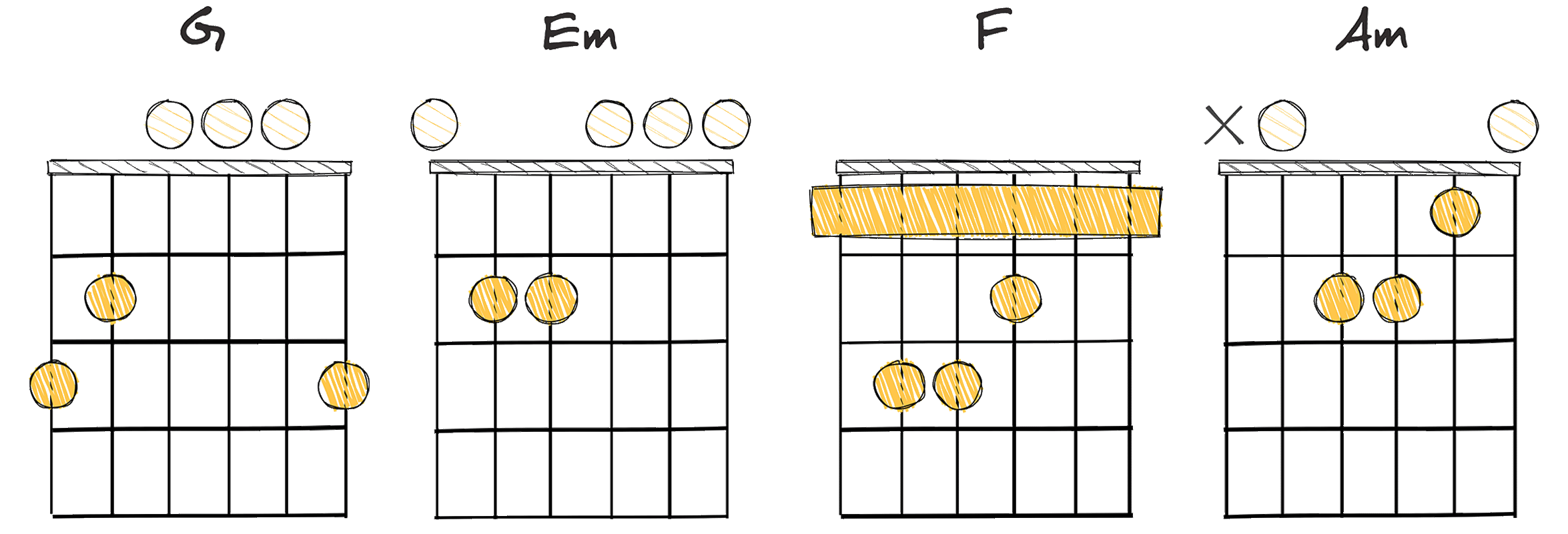
The V – iii – IV – vi or otherwise known as 5 – 3 – 4 – 6 chord progression is a distinctive chord sequence frequently encountered across various musical styles, including the innovative realm of trap music.
This progression has echoes in classical music, where it played a role in crafting emotive melodies and contrasts.
Centered around the movement from the fifth (dominant) chord to the third (mediant), followed by the fourth (subdominant), and ending with the sixth (relative minor) chord, this progression creates a compelling sonic experience.
The 5-3-4-6 chord progression is celebrated for the emotional resonance it orchestrates between dynamic movement and melodious calm.
This balance is encapsulated in the interplay between the dominant and mediant chords that provide movement, and the subdominant and relative minor chords that add depth and texture.
Shifting from the uplifting energy of the dominant to the complex melancholy of the mediant, and then to the breadth of the subdominant and relative minor, it carves an emotional path that makes trap beats truly resonate.
Its intermediate complexity offers a profound canvas for musical expression, and when applied with finesse, it amplifies the emotional impact of trap beats.
The progression’s rich lineage in classical music and its fresh infusion into contemporary genres bestows it with a versatility that translates into a unique flavor for your trap tracks.
Moreover, the V – iii – IV – vi progression is not just a tool for forging emotional melodies but a cornerstone for constructing the rhythmic architecture of memorable trap hooks.
From the viewpoint of a producer, grasping this progression is akin to wielding a master key to unlock new musical horizons.
But the authentic allure of the 5 – 3 – 4 – 6 progression is found in its pliability.
With an artistic touch and inventive reimagining, it can metamorphose into an extraordinary trap beat, fueling your creativity to soar to uncharted heights.
These insights are merely the framework.
Your unique creative intuition is the essence that will make your trap creations thrive and echo with originality.
I – iii – vi – IV (1 – 3 – 6 – 4)
A unique melodic journey with unexpected harmonic twists.
The I – iii – vi – IV chord progression is a dynamic sequence, often used in Trap music, that creates a melancholic yet energetic atmosphere. This progression, popular for its departure from traditional major to minor shifts, provides tension and unpredictability, which can significantly augment the dynamism of your beats.
- Difficulty: Intermediate
- Example: C – Em – Am – F (Key of C)
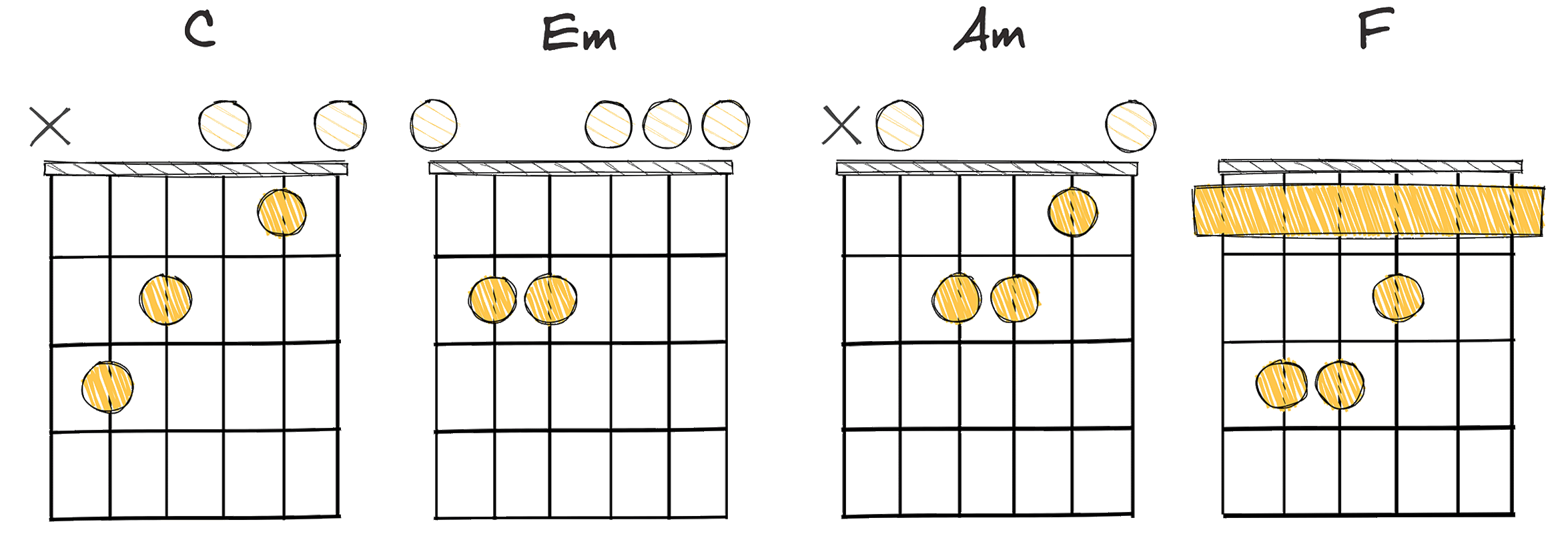
Learning to incorporate the right trap chord progressions can significantly transform your beats.
Today’s discussion revolves around the intermediate-trap chord progression: I – iii – vi – IV (1 – 3 – 6 – 4) or C Major – E minor – A minor – F Major in the key of C.
This is not a random sequence, it’s an intentionally deliberate sequence that has stood the test of time because of its potent resonance.
This progression is rooted in music history, introduced and later embraced in several genres, ultimately taking a prime position in trap music production.
Being based on an historic progression, it inherently carries a measure of musical nostalgia.
This nostalgia layered with new-age trap beats creates a compelling mix, making it a favorite among trap producers.
The chord sequence starts with a C Major, giving the progression a firm foundation on which to build.
Following that, an E minor chord alters the tone, introducing a darker, brooding element.
In moving to the A minor chord, one heightens the tension, cementing the suspenseful mood introduced by E minor.
Finally, transitioning to the F Major chord resolves the tension, offering the listener a brief respite before the progression restarts.
One of the beauties of this sequence is its musical versatility.
Despite its popularity within the trap genre, this progression isn’t defined by it, as it’s malleable enough to be potentially incorporated into pretty much any music genre.
As an Intermediate level progression, navigating this arrangement is fairly straightforward, offering an opportunity for producers trying to transition from beginner levels to put their skills into practice.
At the same time, advanced producers can find ample room for experimenting and further refining this classic sequence to suit their unique style.
Hence, whether you are just starting or a seasoned music producer, don’t hesitate to experiment with the I – iii – vi – IV progression in your track compositions.
Never forget, the key element here is consistent practice.
ii – vi – iii – IV (2 – 6 – 3 – 4)
A melancholic blend that’s reflective and resonant in trap music..
The ii – vi – iii – IV progression with the chords Dm – Am – Em – F in C major creates an emotional journey. The transition from minor to major chords crafts a melancholic yet intricate sound, offering a blend of reflective and wistful tones. Its unique character makes it suitable for various musical expressions, including trap music.
- Difficulty: Easy
- Example: Dm – Am – Em – F (Key of C)
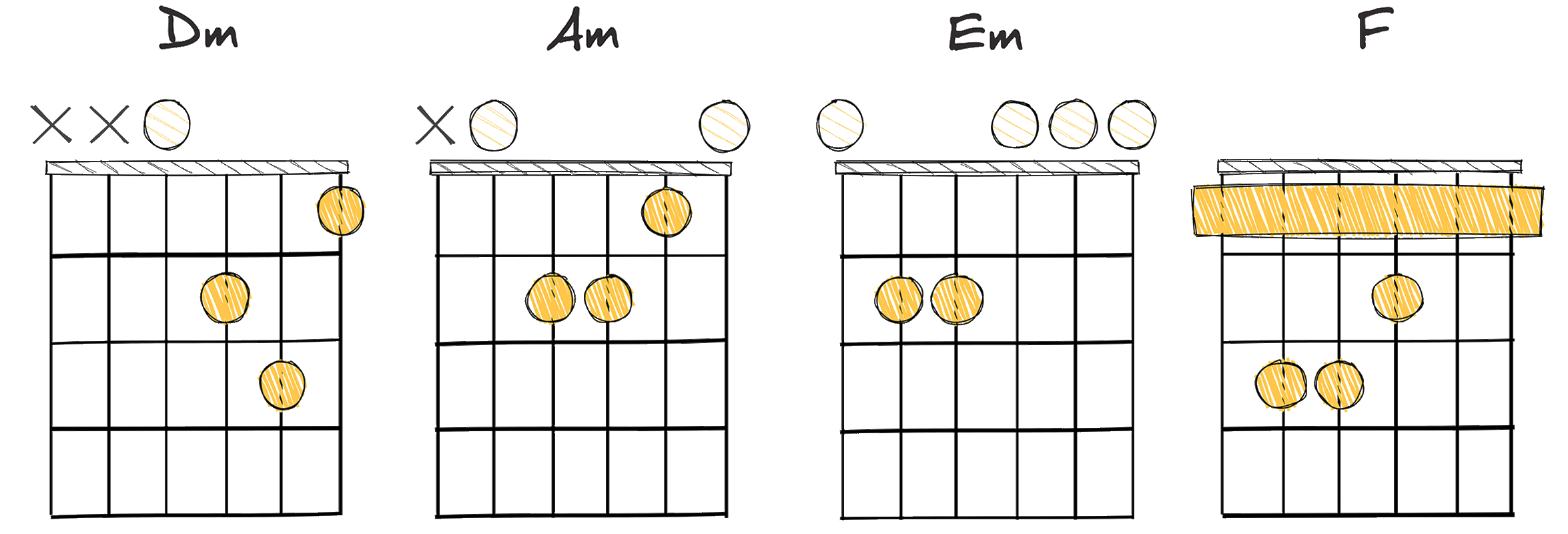
The progression ii – vi – iii – IV, or in the key of C, Dm – Am – Em – F, holds a particular charm within the vast spectrum of music, fitting seamlessly into the fabric of trap, where it adds a melancholic yet intricate texture.
Its accessibility and the fluidity of transitions between these chords make it a favored choice among musicians, with the movement between minor and major chords providing an engaging playing experience.
Historically, this progression weaves through both classical and contemporary musical landscapes, creating a bridge that connects time-honored traditions with modern auditory expressions.
The sequence from the minor-ii chord to the minor-vi and then to the minor-iii, culminating in the major-IV chord, crafts a layered tension and emotion that resonates strongly within trap music.
The ii – vi – iii – IV progression opens doors to creativity and innovation in your trap beats, offering a multifaceted musical tool to explore and redefine.
Its application can vary to evoke different sensations within your trap composition.
A higher octave may lend a haunting delicacy, while a lower one might infuse a rich, profound depth into your beat.
Moreover, the rhythmical versatility of this chord progression can breathe life into your trap beats, making them both compelling and memorable.
Its enduring presence in the musical world has rendered this progression a familiar pattern, yet the magic lies in its endless adaptability.
The avenues to explore with the ii – vi – iii – IV progression are vast and varied, inviting you to delve into the unknown and sculpt a soundscape that transcends the ordinary.
So, how will you weave the ii – vi – iii – IV progression into your next trap masterpiece?
Embrace it not as a mere template but as a springboard for your creativity, adding your distinctive flair to etch your mark in the ever-evolving universe of trap music.
To cap it all, it’s vital to appreciate that while the ii – vi – iii – IV chord progression might be a familiar face in musical chronicles, its true power and potential reside in your hands, awaiting your touch to awaken its full splendor.
I – V – vi – IV (1 – 5 – 6 – 4)
A universally popular chord progression adding dramatic flair to Trap beats.
The I – V – vi – IV progression brings depth and versatility to trap music, underpinning melodic complexity with a bassline that balances a sense of familiarity and anticipation. This iconic sequence, with its oscillation between major and minor chords, can be manipulated in rhythm, pitch, and instrumentation to create nuanced, emotionally resonant beats in trap and a myriad of other genres.
- Difficulty: Easy
- Example: F – C – Dm – Bb (Key of F major)
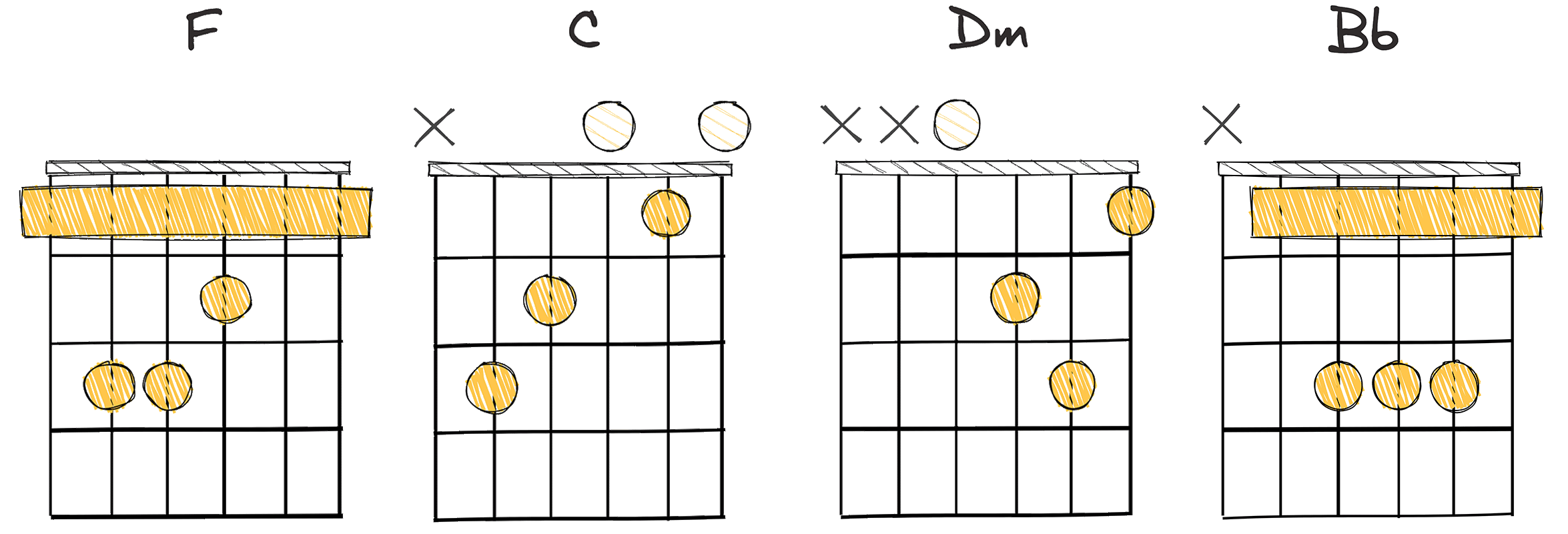
In discussing the trap chord progression I – V – vi – IV (1 – 5 – 6 – 4), it’s vital to acknowledge that it holds a significant place in the world of music theory and composition.
Regarded as easy to play, it has been a favorite in many music genres throughout history.
Functioning as a essential basis for countless songs, it’s notably employed within trap music, bringing an irresistible rhythmic structure that effectively captures the listener’s attention.
The great thing about this chord progression is that it’s flexible, thus it integrates seamlessly into the unique dynamic realm of trap beats.
Resulting in a perfect balance of tension and release, the I – V – vi – IV progression creates an engaging rhythmic and melodic journey for both the artist and the listener.
The I – V – vi – IV progression has been implemented in numerous successful trap songs, contributing deeply to the genre’s distinctive sound.
By putting this progression at the center of a composition, trap producers can generate contrasting moods and provoke deep emotional responses.
The steady rhythm this progression provides underlines the rapid hi-hat rolls and sharp snare hits characteristic of many trap beats.
Moreover, it’s worth noting that the I – V – vi – IV progression presents opportunities for musical development and expansion within a composition.
As a chord progression, it is easy to play and offers a great starting point for those new to producing trap beats.
Increasing its utilization in trap music will indeed elevate your beats to the next level.
In conclusion, we must not underestimate the impact of the I – V – vi – IV progression on the trap genre.
By fully understanding and exploiting this progression, producers can undoubtedly improve the quality of their beats and broaden their musical repertoire.
vii° – I – iii – IV (7 – 1 – 3 – 4)
A versatile and emotive musical expression.
The vii° – I – iii – IV progression in C major (Bdim – C – Em – F) creates a compelling musical journey, beginning with tension in the B diminished chord, moving to resolution with C major, and then meandering through emotional depth with E minor, culminating in stability with F major. Its combination of emotions and textures makes it adaptable in genres like trap music.
- Difficulty: Intermediate
- Example: Bdim – C – Em – F (Key of C)
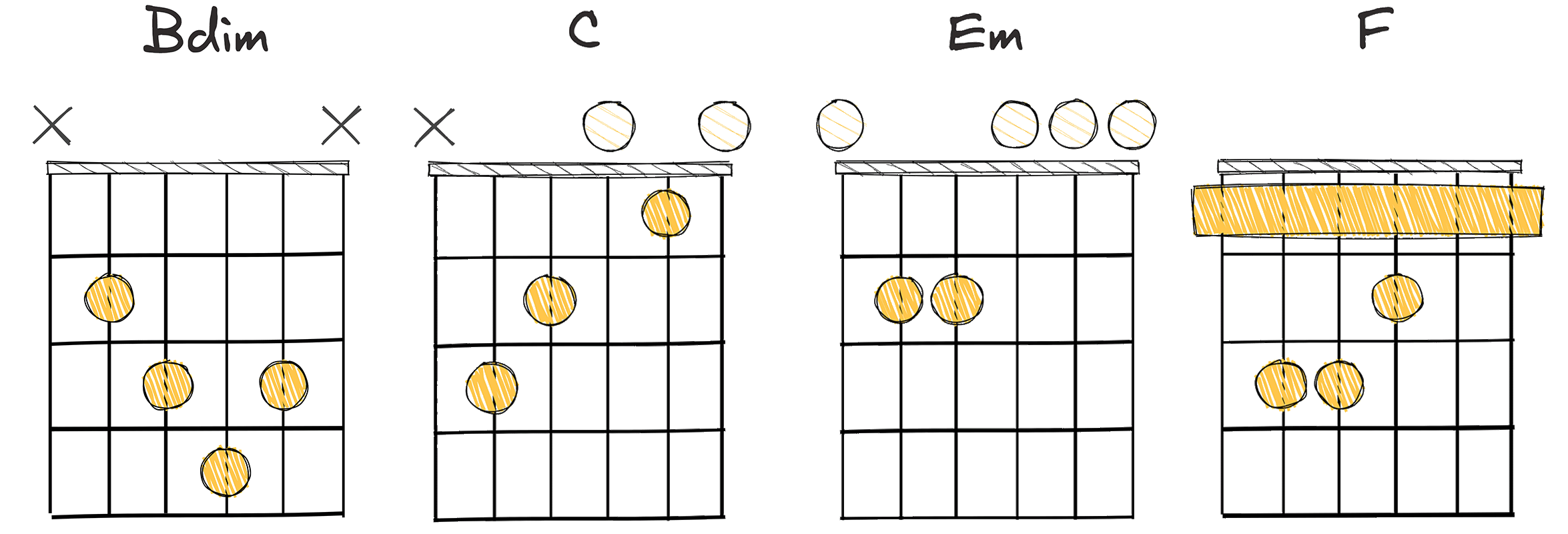
When we delve into the modern landscapes of electronic and trap music, the harmony and flow are often dictated by innovative chord progressions.
One such captivating progression is the vii° – I – iii – IV or B diminished – C major – E minor – F major in the key of C.
This sequence masterfully weaves tension and release, forming the backbone of many poignant trap compositions.
The B diminished chord introduces a dissonant intrigue, while the C major sweeps in with resolution and warmth.
The subsequent E minor chord injects an emotive depth, and the F major concludes the progression with a calming stability.
The essence of this progression lies in its dynamic range and expressiveness.
Whether instilling a rhythm with raw energy or painting an ambient soundscape, this progression molds itself seamlessly to the desired atmosphere.
The vii° – I – iii – IV progression marks a resonant touch in trap music, infusing pieces with a multifaceted emotional canvas.
It’s not merely a combination of chords; it’s an orchestrated experience capable of channeling diverse sentiments and narratives within trap music.
Its depth and eloquence have rendered it a go-to progression for innovative producers.
While it may present intermediate challenges for musicians, its limitations bow to the boundless creativity it spawns.
Its history echoes through various musical eras, being an essential ingredient in compositions transcending genres.
Its contemporary prominence in trap stands as a tribute to its ageless charm and practicality.
The vii° – I – iii – IV progression enables producers to craft vivid emotions and ambiance with just four chords.
Its adaptability and efficacy liberate creativity, encouraging producers to explore facets beyond harmony, thus enriching the musical fabric.
Grasping this progression is akin to unlocking a treasury of emotive resonance, waiting to be channeled and blended into your singular artistic expression.
The exploration of these chords may lead to unexpected paths in the vast world of trap music, infusing it with a timeless touch.
V – I – IV – iii (5 – 1 – 4 – 3)
A smooth journey from triumph to introspection, fueling immersive trap beats.
This V – I – IV – iii chord progression, typically associated with trap music, uses a transition from the dominant fifth to the tonic first, followed by a move to the subdominant fourth and mediant third. This sequence evokes a deep, dramatic vibe, essential for crafting hard-hitting beats and elevating your music production skills.
- Difficulty: Easy
- Example: D – G – C – Bm (Key of G)
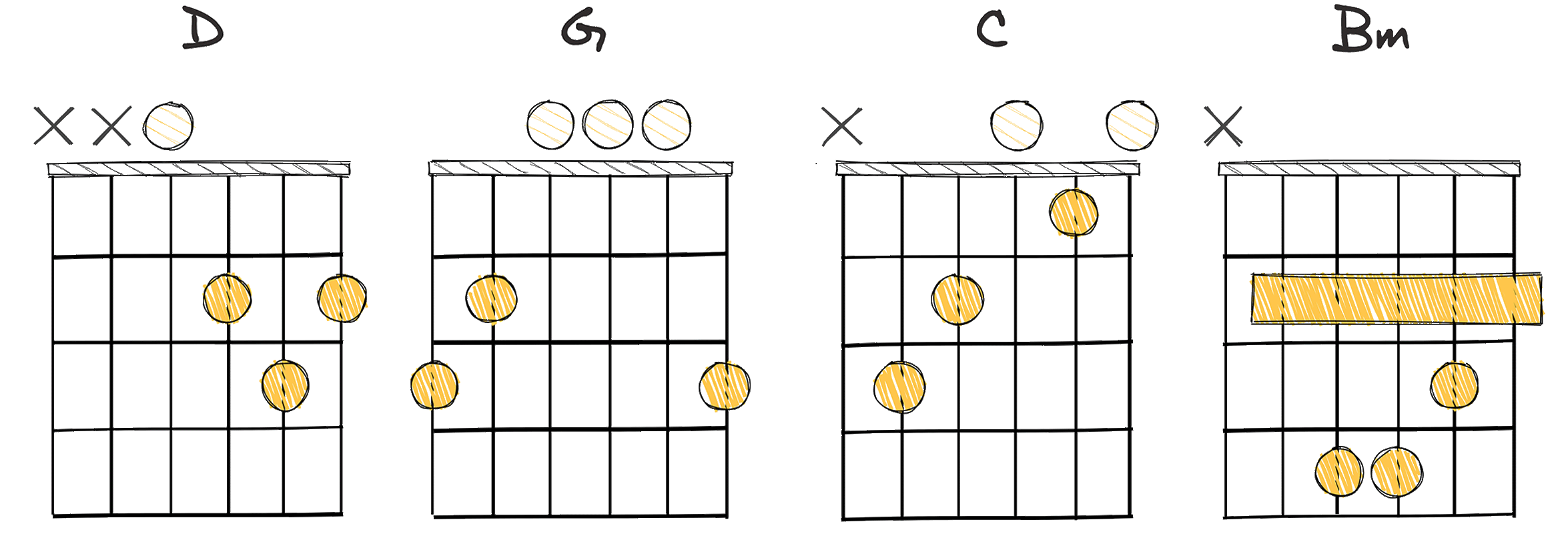
The chord progression V – I – IV – iii, or in the key of G, D – G – C – Bm, is a powerful tool in the world of trap music production.
Due to its simple structure, this progression is easy to play and offers a variety of musical possibilities, providing the backbone for some of the most popular trap beats.
The distinct, unforgettable melodies that can be created using this progressional structure truly have the power to elevate your beats to new heights.
In trap music, chord progressions like this play a significant function in setting the tone and generating the rhythmic foundation for a track.
From the lively energy of D to the satisfying resolution of G, the journey from the tense prelude of C or the surprising finale of Bm, every chord in this progression oozes potential for atmospheric, hypnotic trap beats.
This profound statement encapsulates why the progression V – I – IV – iii is so influential in trap music.
The progression initiates with a strong chord – D, establishing an energetic start.
As it shifts to the G chord, it gives the listener a satisfying sense of resolution.
The transition from G to C sets up a tension-filled prelude that engulfs the listener with anticipation, paving the way for the surprising Bm chord that gives the progression its unique flavor.
Time and again, beat makers have exploited this sequence to create some of the most memorable trap beats, evidencing the progression’s immense potential.
The simplicity of playing this progression allows music producers to focus on what truly matters: crafting a captivating melody and embellishing it with distinctive trap elements — from the iconic 808s to snares and hi-hats.
Understanding this chord progression and learning to exploit it can centralize one’s music production, enabling them to create tracks that leave a lasting impression on the listener.
This formulaic usage can be seen as a guiding map on the journey of creating standout trap beats; the trap producer’s secret weapon is a strategic grasp of chord progressions such as the V – I – IV – iii.
iii – vi – ii – V (3 – 6 – 2 – 5)
Creates an introspective journey, blending melancholy with uplifting resolution.
The iii – vi – ii – V progression in the key of C major (Em – Am – Dm – G) weaves a melodically rich tapestry, starting with an enigmatic Em, cascading into melancholy with Am and Dm, and resolving confidently with G. This sequence offers an introspective and uplifting journey, perfect for infusing depth into trap music.
- Difficulty: Intermediate
- Example: Em – Am – Dm – G (Key of C)
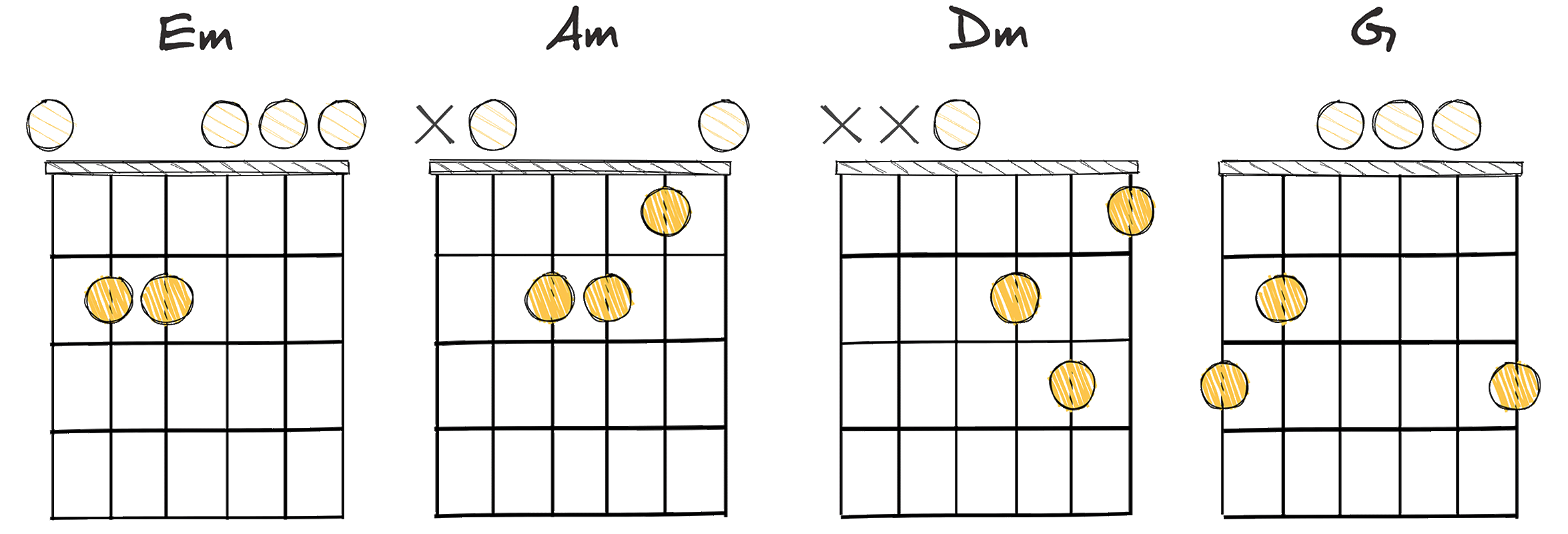
In the immersive realm of trap music production, where beat and rhythm dance together, the iii – vi – ii – V chord progression stands as a remarkable signature.
Represented as Em – Am – Dm – G in the key of C major, it embodies a vast universe of creative potentials for music producers.
A rich concoction of minor and major chords, this progression offers an emotional depth that’s intriguing and stimulating to both the creator and the listener.
Its origins can be traced back to the jazz era, a time when it sparkled and shined, but today, it serves as an extraordinary tool for sculpting evocative trap beats.
During practice, a producer may dissect this progression chord by chord to truly understand its unique character.
Em kicks it off with an enigmatic tone, followed by the sorrowful Am, the contemplative Dm, and finally, the resolute G major, forming a harmonious and satisfying finish.
Its intermediate level of playability doesn’t hold back the imagination; instead, it fuels creativity and skill, making it an ideal choice for crafting thrilling trap beats.
Just as jazz musicians of the past embraced this progression, its captivating auditory appeal has been revived in modern trap music.
Its ability to draw the listener into an immersive experience has made the iii – vi – ii – V progression a sought-after sequence for contemporary producers.
With careful practice and keen understanding, this chord progression becomes more than just a series of notes; it becomes a powerful expression in a producer’s musical lexicon.
Infusing personal stylistic nuances into this progression allows for the crafting of distinctive trap beats, leaving an indelible mark on the listeners’ hearts and minds.
vi – IV – ii – V (6 – 4 – 2 – 5)
Unleash irresistible vibes with this pulsing, cinematic trap progression.
This vi – IV – ii – V chord progression, often found in Trap music, creates an emotive and compelling musical pattern that can add an intricate complexity to your beats. Its descending structure provides a melancholic undertone, yet maintains a balance of tension and resolution, making it great for building suspense and drama in your soundscape.
- Difficulty: Intermediate
- Example: F#m – D – Bm – E (Key of A)
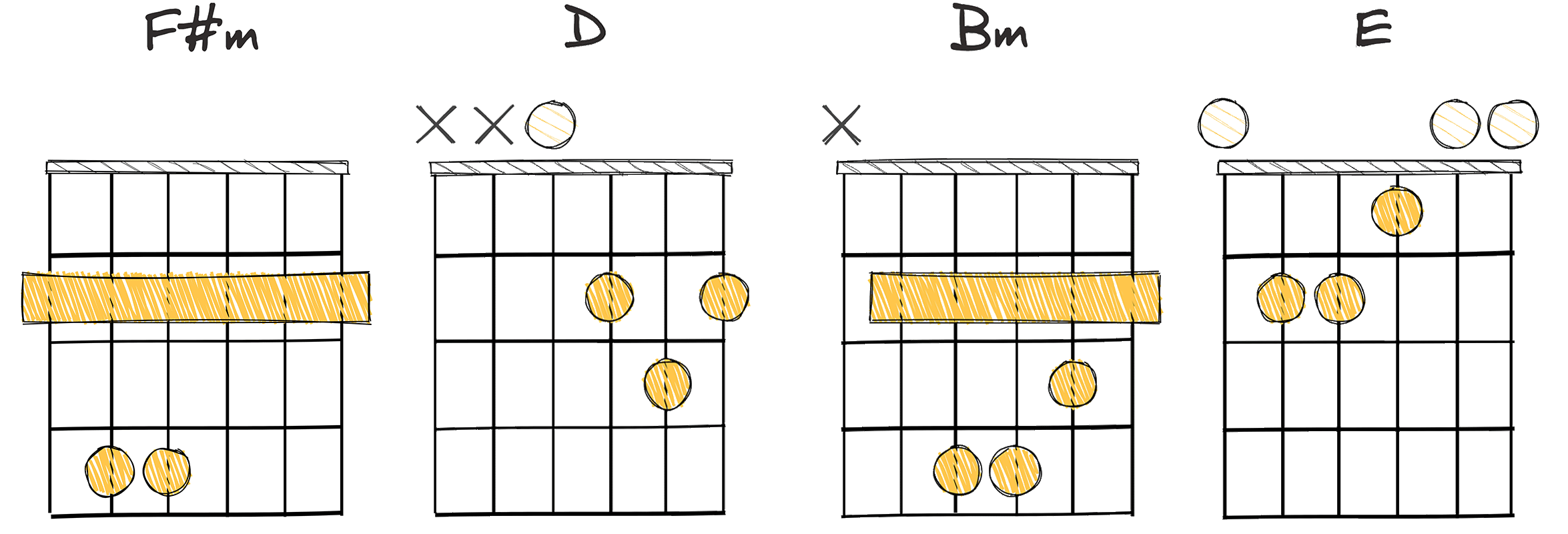
Trap music is a subgenre of hip hop that has grown in popularity in recent years, and much of its appeal lies in its unique use of chord progressions.
The chord progression vi – IV – ii – V, which in the key of A corresponds to the chords F#m – D – Bm – E, is one such progression that has found much use in Trap music.
It is absolutely vital to understand that this progression is of an intermediate level.
While it may appear simple on paper, the subtle nuances of transitioning between these chords can be somewhat challenging for beginners.
Historically, the vi – IV – ii – V chord progression has its roots in classical music.
Back then, composers reveled in the melodic and harmonic possibilities of this progression.
Even today, the nostalgic and poignant feelings elicited by the vi – IV – ii – V progression make it a favorite choice among many contemporary producers.
This progression’s charm lies in its unique movement and resolution.
The transition from the submediant to the subdominant, followed by the supertonic and ending on the dominant, creates an incredibly satisfying musical journey.
Beyond just Trap, this progression is versatile and can be used in virtually any musical genre, from pop to R&B, to indie rock and beyond.
The emotional breadth and reach that the vi – IV – ii – V progression possesses is truly remarkable.
As a trap music producer or aspiring beat maker, understanding and mastering the vi – IV – ii – V chord progression could add a new layer of depth to your compositions.
The intermediate level of this progression is no deterrent; in fact, it should be seen as an opportunity to grow and refine your skills in a truly meaningful way.
By incorporating the vi – IV – ii – V progression into your trap beats, you can count on producing music that is not only engaging and fresh but also deeply emotive and resonant.
In a genre that is often criticized for its perceived lack of musical complexity, the use of such progressions serves as proof of the innate musicality and creativity that exists within the world of Trap.
The rich history, versatility, and emotive potential of the vi – IV – ii – V chord progression make it a truly valuable tool in the toolkit of any trap producer.
ii – IV – I – vi (2 – 4 – 1 – 6)
An unexpected, captivating chord progression for innovative trap beats.
This ii – IV – I – vi chord progression is relatively popular in trap music due to its smooth melodic transition and somewhat melancholic tone. It creates an appealing emotional depth and dramatic tension in beats, thereby giving the music an intriguing appeal that can draw in listeners.
- Difficulty: Intermediate
- Example: Dm – F – C – Am (Key of C)
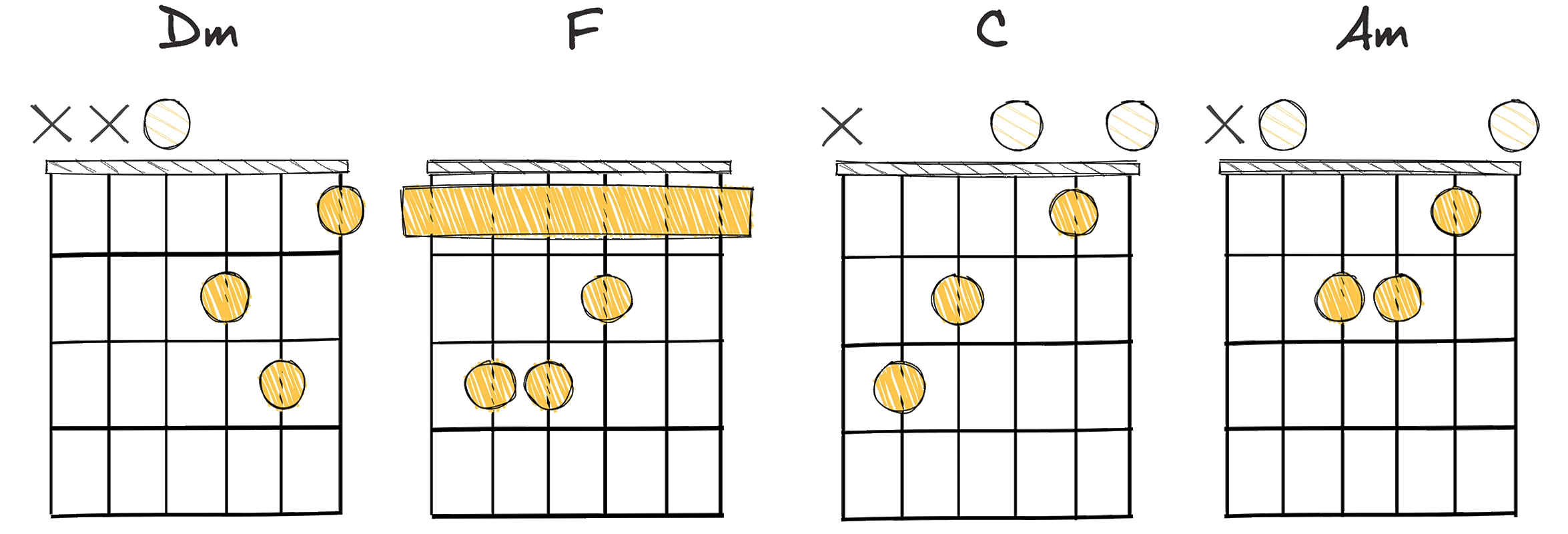
When discussing trap music, it is essential to mention its unique chord progressions that set it apart from other music genres.
The ii – IV – I – vi chord progression, also known as Dm – F – C – Am in the Key of C, is a popular choice in trap production due to its versatility and emotional resonance.
This particular chord progression conveys a strong emotional tone that aligns perfectly with the raw, gritty aesthetics of Trap music.
It is important to note that trap music is precisely about rawness and authenticity, and this chord progression wonderfully magnifies these attributes.
Furthermore, the ii – IV – I – vi progression is not overly complicated, making it a popular choice among producers of various skill levels, from beginners to eminent professionals.
In the trap music industry, this chord progression has been widely used, and its popularity demonstrates the restless creativity of musicians and producers alike.
Traditionally, this progression is considered intermediate in terms of its technical complexity.
Therefore, it requires a reasonable level of proficiency on a given instrument but also offers an engaging challenge to musicians looking to elevate their sound and skills.
Generations of musicians have utilized this progression, contributing to its rich history that dates back to the earlier manifestations of trap music.
This progression’s memorable sound has pervaded numerous trap tracks, creating an identifiable sonic trademark within the genre.
The use of the ii – IV – I – vi progression adds an element of unpredictability to the music, keeping listeners on their toes and reinforcing the intensity at the heart of Trap music.
Finally, while this progression might not initially seem as exciting as some other chord progressions, its robustness and emotional depth make it a consistently popular choice among trap producers.
Thus, mastering this progression can significantly elevate one’s beats and contribute to the evolution of the trap genre.
Each chord progression offers its own ‘flavor’, and the ii – IV – I – vi progression undoubtedly brings a rich, emotional, and intense tone to trap music, indispensable for any ambitious producer.
I – IV – vii° (1 – 4 – 7)
Unleash edgy vibes with this unconventional, mood-boosting chord progression.
This chord progression moves from the tonic chord to the subdominant, and then ascends to the seventh, creating an unexpected yet pleasing resolution. This unique progression not only adds complexity to a track but also provides an uplifting groove, making it ideal for creating dynamic beats in the trap genre.
- Difficulty: Easy
- Example: C – F – Bdim (Key of C Major)
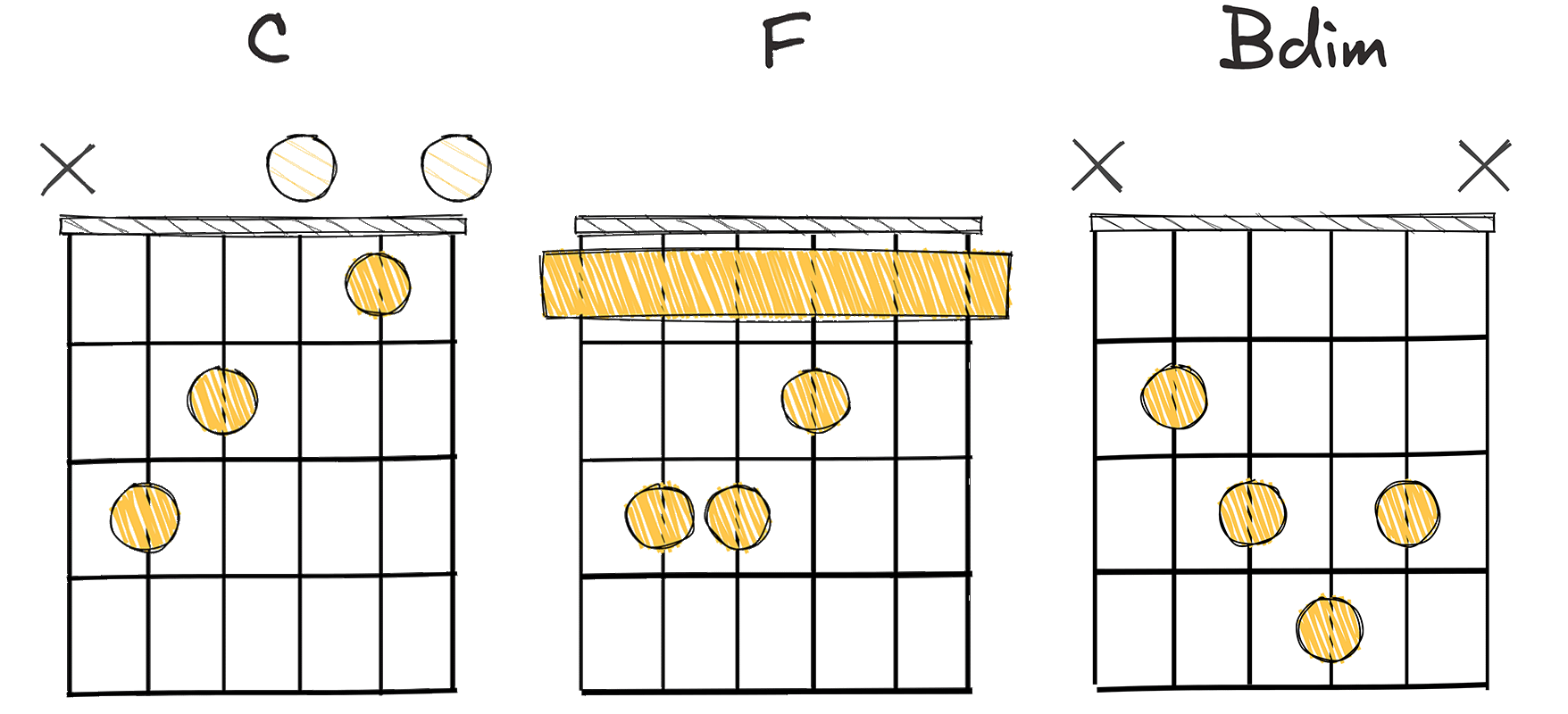
Exploring trap chord progressions is a fantastic way to delve deeper into producing unique beats.
The I – IV – vii° (1 – 4 – 7) chord, or in the example of C Major – F Major – B Diminished, provides an excellent example of this.
These chord progressions offer a powerful tool for creating trap beats with a fresh twist.
Their strategic implementation can transform a regular trap beat into a unique production.
Historically, chord progressions have played a crucial role in music.
They set a harmonic framework that dictates the course of a musical composition.
Trap music is no exception to this rule.
Popularized in the southern United States, trap music originally drew upon the dark, gritty realities of urban life.
It was critical for the instrumental backing to reflect this.
The I – IV – vii° chord progression was a key component in achieving this, providing the sinister and atmospheric sound synonymous with trap music.
The innovation of trap music was largely driven by its adoption of distinctive chord progressions such as the I – IV – vii°.
This chord progression stands out in its deviation from the more common chord sequence – I, IV, V (1, 4, 5).
Instead, the I – IV – vii° leans towards a more dramatic and edgy sound.
This sound played a significant role in setting trap music apart from other music genres.
It also helped it to resonate deeply with its first audiences and has contributed to why it is still loved and produced today.
Importantly, because of their simplicity, these chord progressions are relatively easy to play.
Their implementation does not require complex music theory knowledge, making them accessible for beginners.
This simplicity has led to their widespread use in a range of hit trap songs.
It’s essential to remember that chord progressions are only one aspect of making a great trap beat.
Along with the right samples, sound design, mixing techniques, and unique creativity, they can transform your production.
By experimenting with different chord progressions like the I – IV – vii°, beat makers can unlock a whole new realm of possibilities.
I – ii – vi – IV (1 – 2 – 6 – 4)
Unconventional, uplifting progression adding unique flair to your trap beats.
This is a unique and dynamic chord progression that can be used to bring a fresh and innovative sound to many trap beats. The progression moves from the tonic (I), to the supertonic (ii), then to the relative minor (vi), ending with the subdominant (IV), creating an unpredictable and engaging harmonic journey.
- Difficulty: Easy
- Example: F – Gm – Dm – Bb (Key of F)
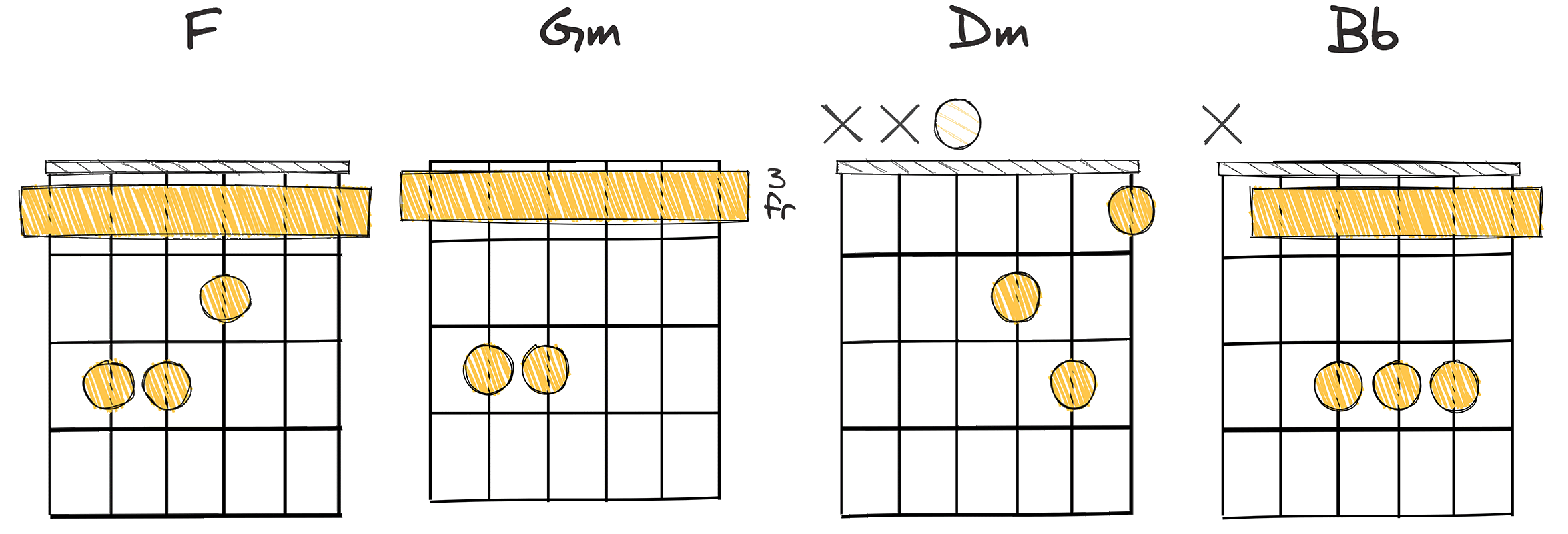
In the realm of music production, knowing how to construct a powerful chord progression is paramount to crafting a hit that resonates with your audience.
One such progression that has stunned many with its simplicity yet effective musical narrative is the I – ii – vi – IV (1 – 2 – 6 – 4) trap progression.
Originating from the genre’s love for unique yet catchy harmony, this progression has been the driving force behind countless trap melodies.
The I – ii – vi – IV chords progression is favored for its ease of play and it’s adaptable qualities, effortlessly giving life to the bold and dynamic tunes that trap music is known for.
This progression, whilst seemingly simple on the surface, provides an atmospheric soundscape that is undeniably compelling to listeners when complemented by a refined beat.
Trap music, is known for its rich history of pushing rhythmic boundaries, something the I – ii – vi – IV progression reflects seamlessly.
The first chord of this sequence is built from the first degree of the scale – the I or 1 – giving the progression its tonal foundation and resolving quality.
Bold and stable, it’s then met with the next chord, ii or 2, immediately introducing a unique touch of tension into the melody.
This chord, a tone away from the initial I chord, gives a surprising transition that grips the listener’s attention.
The vi or 6, the next chord in the progression, brings an even more dramatic dynamic, injecting a deep sense of melancholy and emotiveness that trap music is widely identified with.
This moodier chord after the punchier II makes the progression truly versatile, catering to trap’s wide array of sub-genres from the fluidity of cloud trap to the intense vibes of hard trap.
Finally, the progression is rounded off by the IV or 4 chord that effortlessly brings the music back to its tonal resolution, accurately creating a sense of completeness yet nuance in the melody.
In every measure, this progression sheds a different light on trap music, proving that its simplicity does not limit its ability to create impactful and resonate tunes.
As sophisticated as it is effective, the I – ii – vi – IV progression has undisputedly elevated the complexity and appeal of trap music.
Despite its repetitive nature, it never ceases in its capacity to create unforgettable trap beats.
vii° – iii – vi – ii (7 – 3 – 6 – 2)
An unexpected and soft shift for a suspenseful trap atmosphere.
This progression features a vii° – iii – vi – ii sequence that delivers a sense of tension and resolution, adding dynamism to your tracks. It is a classic choice for trap music and other electronic genres, giving them a distinctive edge and a captivating rhythmic foundation.
- Difficulty: Intermediate
- Example: G#dim – C#m – F#m – Bm (Key of A)
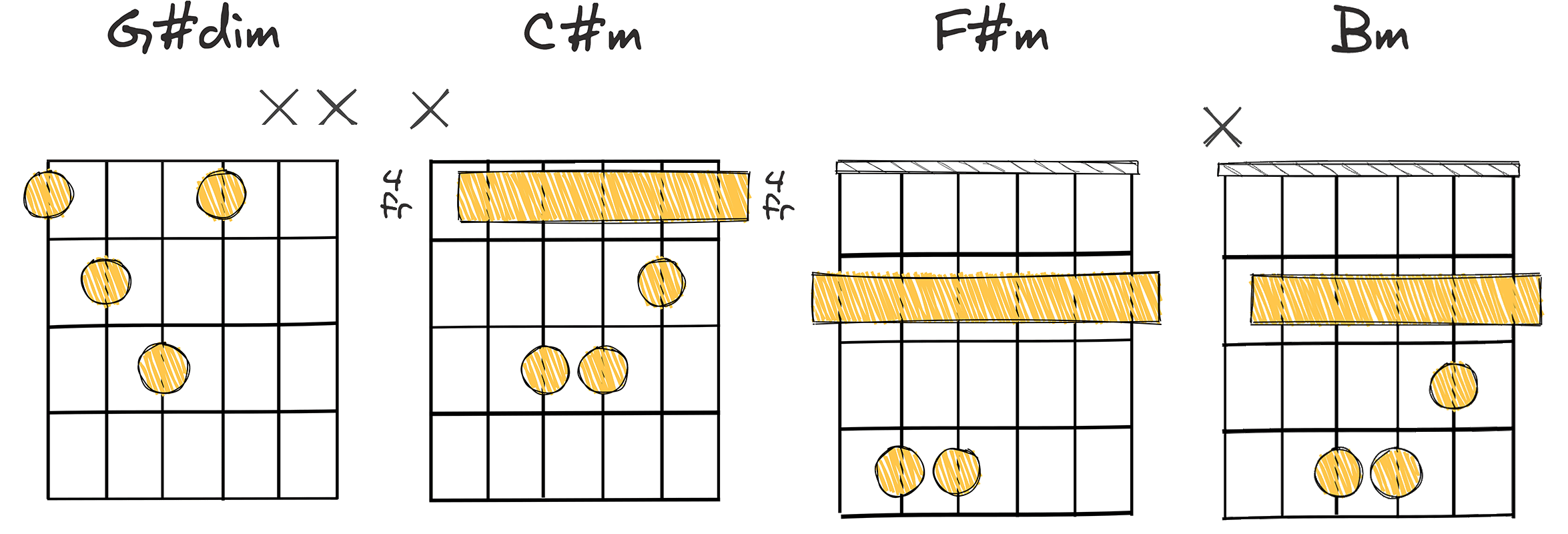
The chord progression of vii° – iii – vi – ii (7 – 3 – 6 – 2) in the key of A major translates as G#dim – C#m – F#m – Bm.
This progression creates a compelling and unforgettable rhythmic pattern which has a unique quality to transform beats into a sonic masterpiece.
This chord progression was widely adopted as far back as the classical era but has found a resurgence in recent years in the realm of trap music.
Its appeal lies in its versatility, as it can be applied across genres such as classic rock, reggae, pop and EDM, to name a few.
Trap music has embraced this progression with vigour, employing it not only in the creation of melodic foundations but also as a tool for enhancing the overall vibe of a composition.
What truly adds to the intrigue of this progression is its unique combination of chords, which provides an almost cinematic feel to the music.
It is fair to suggest that this progression will typically be categorized as intermediate to play.
In respect to its playability, this is often attributed to the chords transition smoothly, with the usage of common tones between the chords making it less challenging.
This eases the player into a sense of familiarity while simultaneously challenging them with an engaging progression.
One of the standout elements involved with this progression is the final leap from F#m back to Bm which, when handled well, can deliver a dramatic and driving force to the music.
Popular music provides us with ample evidence of the prowess of this chord progression.
I – V – ii – IV (1 – 5 – 2 – 4)
Enrich your trap beats – an unconventional yet dynamic progression.
The I – V – ii – IV progression is a signature staple in trap music that adds a moody and atmospheric quality to the beats. By moving from the tonic to the dominant, then to the supertonic and subdominant, this progression offers a sense of tension and release, making it ideal for creating emotionally charged trap melodies.
- Difficulty: Intermediate
- Example: C – G – Dm – F (Key of C)
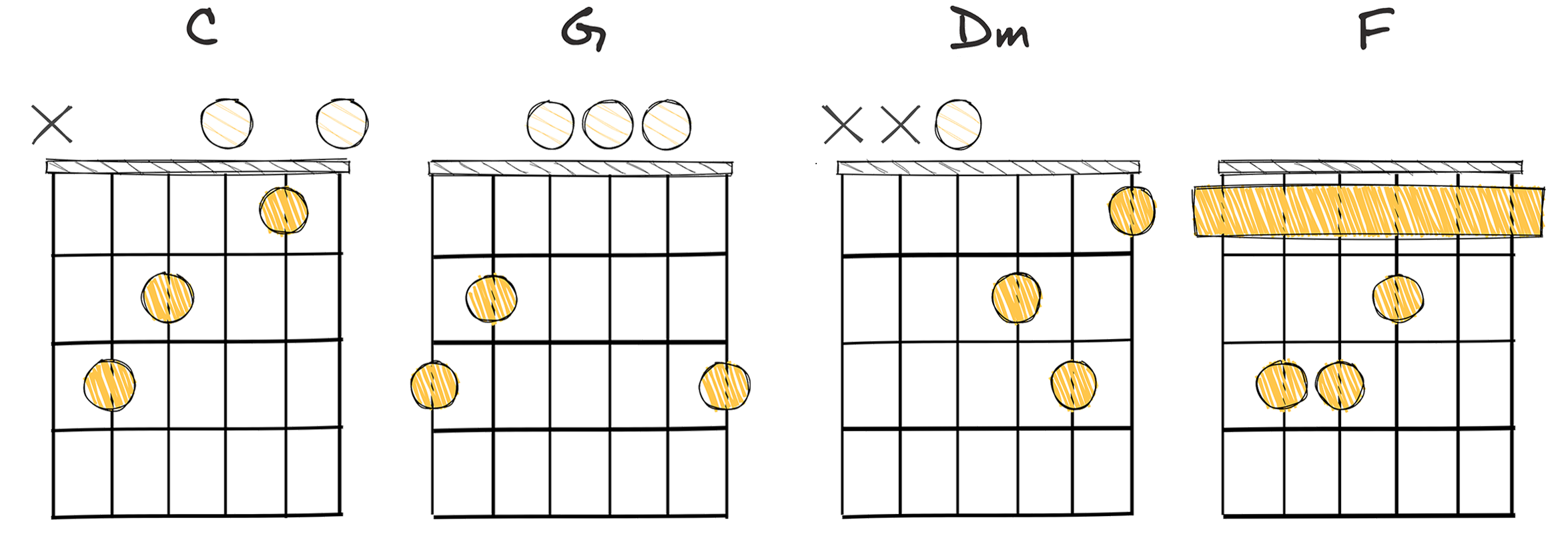
Let’s delve into exploring the I – V – ii – IV (1 – 5 – 2 – 4) chord progression in detail, and how it can help elevate the quality of your trap beats to unforeseen heights.
When structured in the key of C, this progression transforms into the C – G – Dm – F chord sequence.
This specific arrangement includes both major and minor chords, conveying a balance of tension and release.
Trap music, with its deep bass, swooning synth lines, and fast hi-hat patterns, found its roots in the early 2000s in the Southern United States, shaped by artists like T.I. and Gucci Mane.
Despite its intense and closed-off sound, trap music has always revolved around melody, and chord progressions play an integral role in giving it depth and character.
The I – V – ii – IV progression is a ‘four chords of pop’ progression, which is a common formula in the world of popular music.
The I – V – ii – IV chord progression is widely used in many genres, not just trap music, showing its versatility and timeless appeal.
Above quote demonstrates the universality of the I – V – ii – IV chord progression.
With a couple of alterations, these very chords can lay the foundation to hits in a multitude of genres ranging from pop, rock, country, to dance music.
To understand why this concept works so well, we need to grasp the specific characteristics of each individual chord being used.
The I chord, or the tonic, is the home base of any key.
The sensation it provides is similar to returning home after a long journey.
It is the center point, the gravitational force that other chords revolve around.
The V chord, called the dominant, is second in command.
It inherently has a strong desire to resolve back to the tonic, adding an interesting dynamic to the progression.
This is then followed by the II chord, which is minor in quality, and adds a melancholy touch to the mix.
The Dm in the key of C, softens the structure, adding depth and complexity.
Finally, the IV chord, known as the subdominant, has a slightly less push towards the tonic than the V chord but still yearns to find its way back home.
Put together, these four chords offer a rich and complex blend of emotions, resulting in a gratifying and captivating listening experience.
ii – V – iii – IV (2 – 5 – 3 – 4)
From introspection to tension, then eases into wistfulness.
The chord progression of Dm – G – Em – F in the key of C major creates a unique sonic journey. Starting with a reflective tone in Dm, it builds tension with G, softens into a wistful Em, and finally resolves with an uplifting F. This blend crafts a short yet expressive narrative that’s both emotive and harmonically satisfying.
- Difficulty: Easy
- Example: Dm – G – Em – F (Key of C)
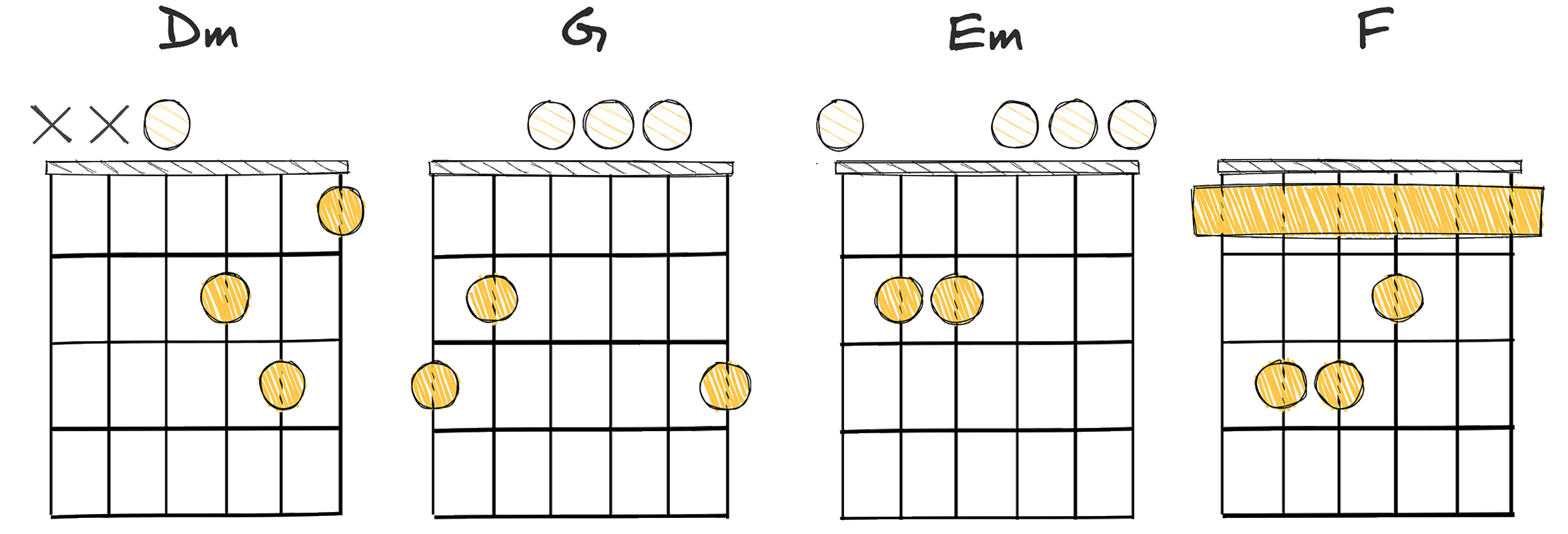
The chord progression ii – V – iii – IV or in the Key of C, Dm – G – Em – F, is a musical arrangement that speaks to the versatility and emotional depth of contemporary music, making it a valuable resource for budding beatmakers and producers.
Much like the fingerprint of musical genres, specific chord progressions have come to epitomize different musical eras, and the ii – V – iii – IV is no exception, representing a connection between traditional harmony and modern creativity.
What sets the ii – V – iii – IV progression apart is its balanced blend of tension and release, offering producers an expressive tool to sculpt beats that resonate with both the mind and heart.
This specific harmony is more than just a sequence of chords; it’s an avenue for emotionally charged storytelling in music, capturing feelings and moments in time.
The simplicity of the chords, combined with the evocative progression they form, has a unique ability to connect with listeners, creating memorable and impactful musical pieces.
Consider many contemporary trap tracks; the likelihood is high that this progression plays a key role in the song’s structure, enhancing its appeal.
Experimenting with the ii – V – iii – IV progression can lead to a deeper exploration of musical creativity, adding layers of complexity and emotional texture to your beats.
The narrative power of this progression, guiding listeners through a musical journey, is a testament to its timeless charm and adaptability.
In the evolving landscape of beat-making, the ability to harness such classic progressions while infusing them with your unique style can lead to new horizons in musical expression.
This ii – V – iii – IV progression is more than just a trend; it’s a reflection of musical evolution, intertwining tradition with modern taste.
With its logical structure and expressive potential, this progression offers a roadmap to create dynamic and compelling music that can captivate your audience.
The Bottom Line
Drawing our discussion to a close, it is evident that studying the range and pattern of these numerical sequences assists in enhancing one’s understanding of the concepts and structures inherent in system design.
These various sequences not only establish different combinations and possibilities but also underline the importance and influence of arrangement and order in any given system.
These representations are not just mere numbers but they hold significant meaning that adds depth and dimension to how systems weave and work together, providing endless opportunities for analysis and creative thinking.
In love with guitars, and gear; expert in all things music! Been writing about guitars for about 5 years and counting. Born in the ’90s. Alma Mater: University of Havana. Always curious, trying to understand the world. #TeamFender




